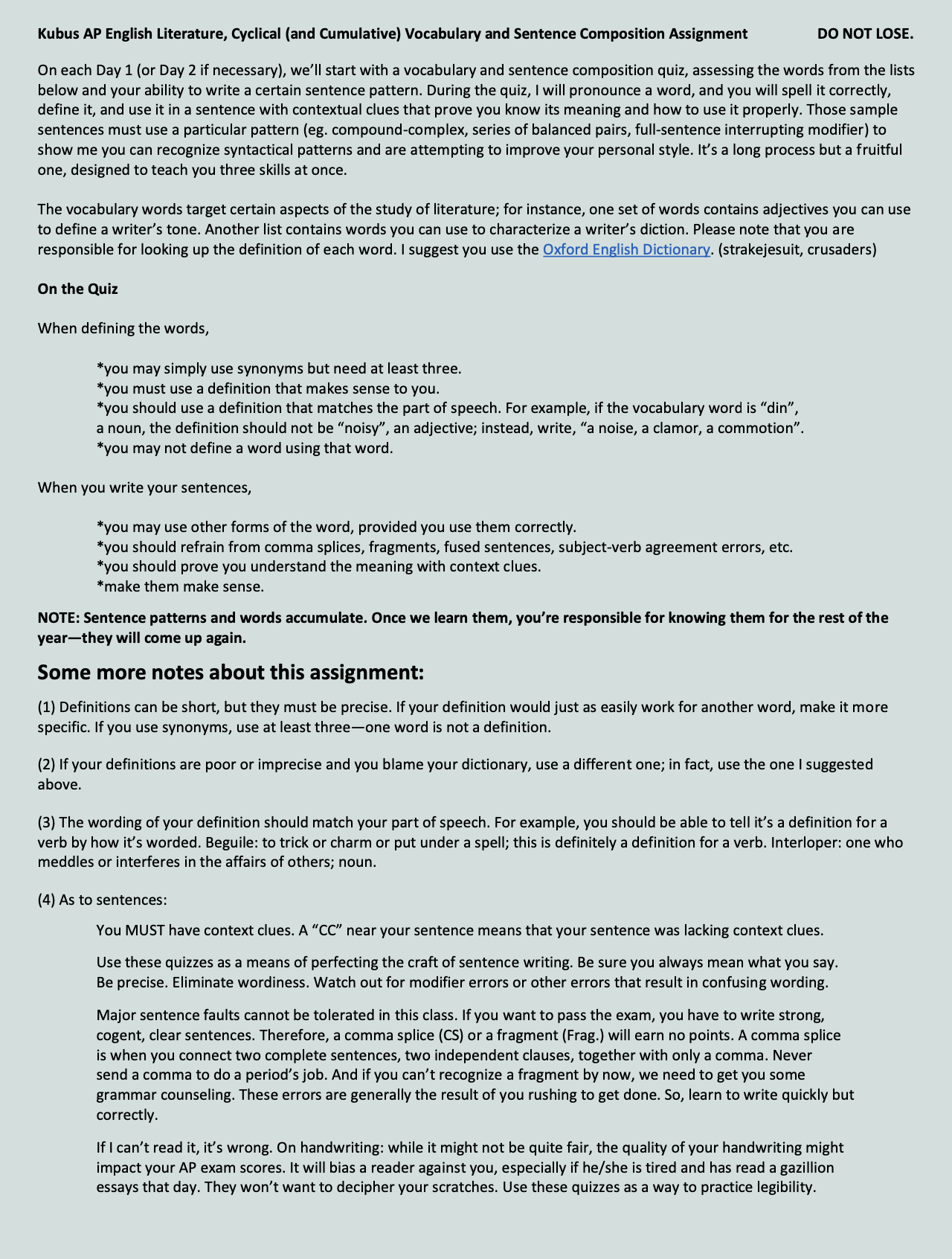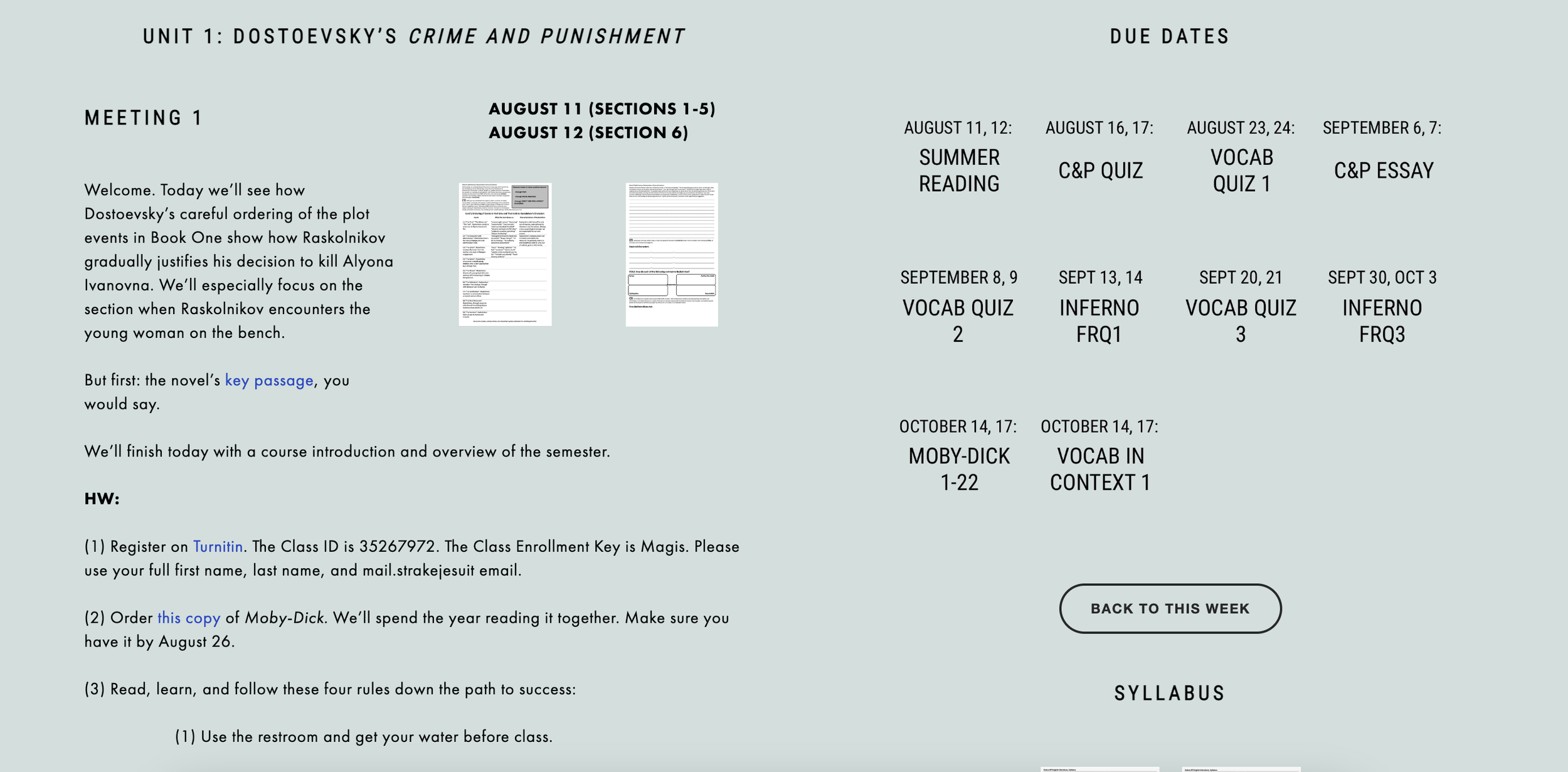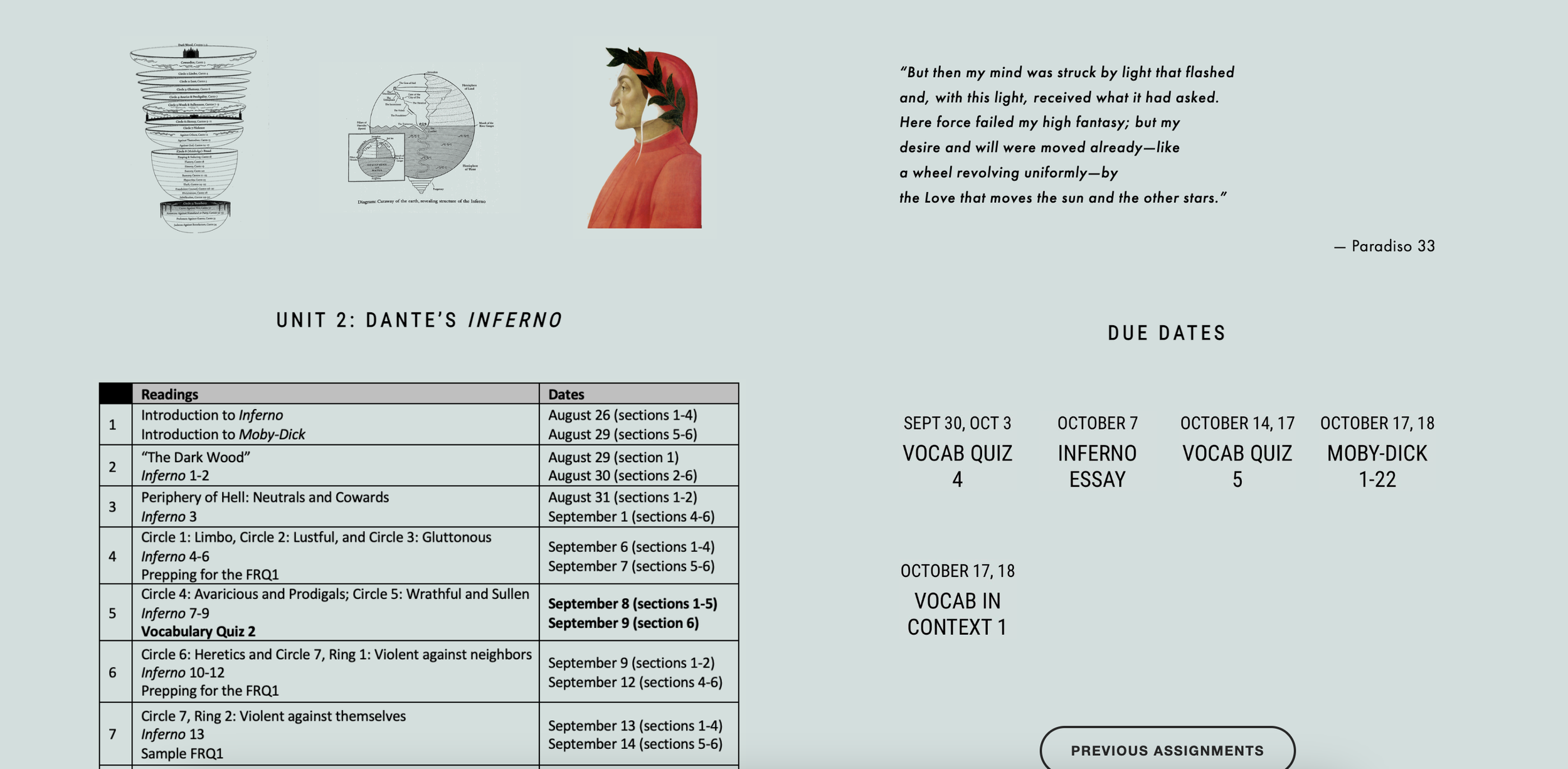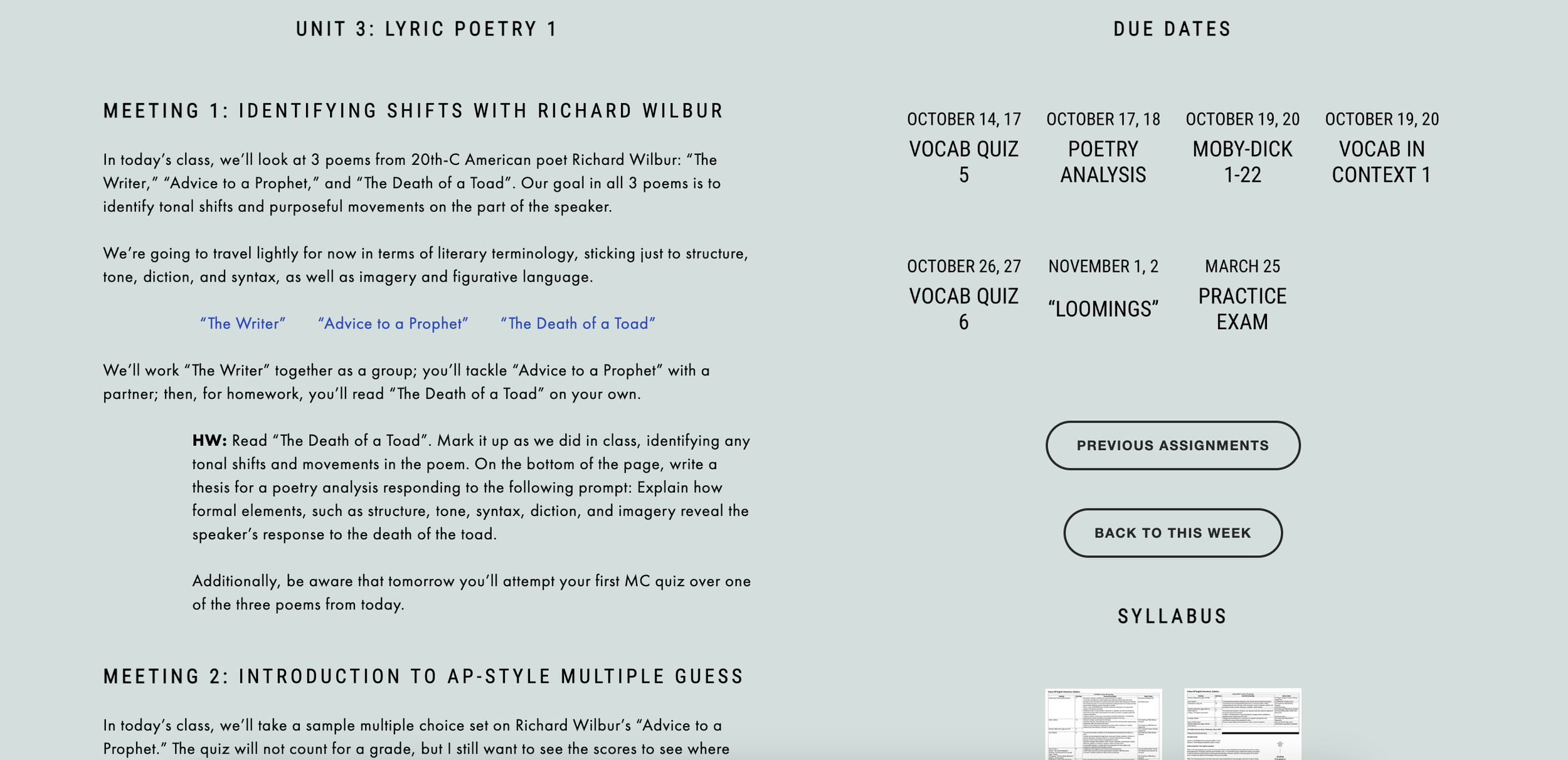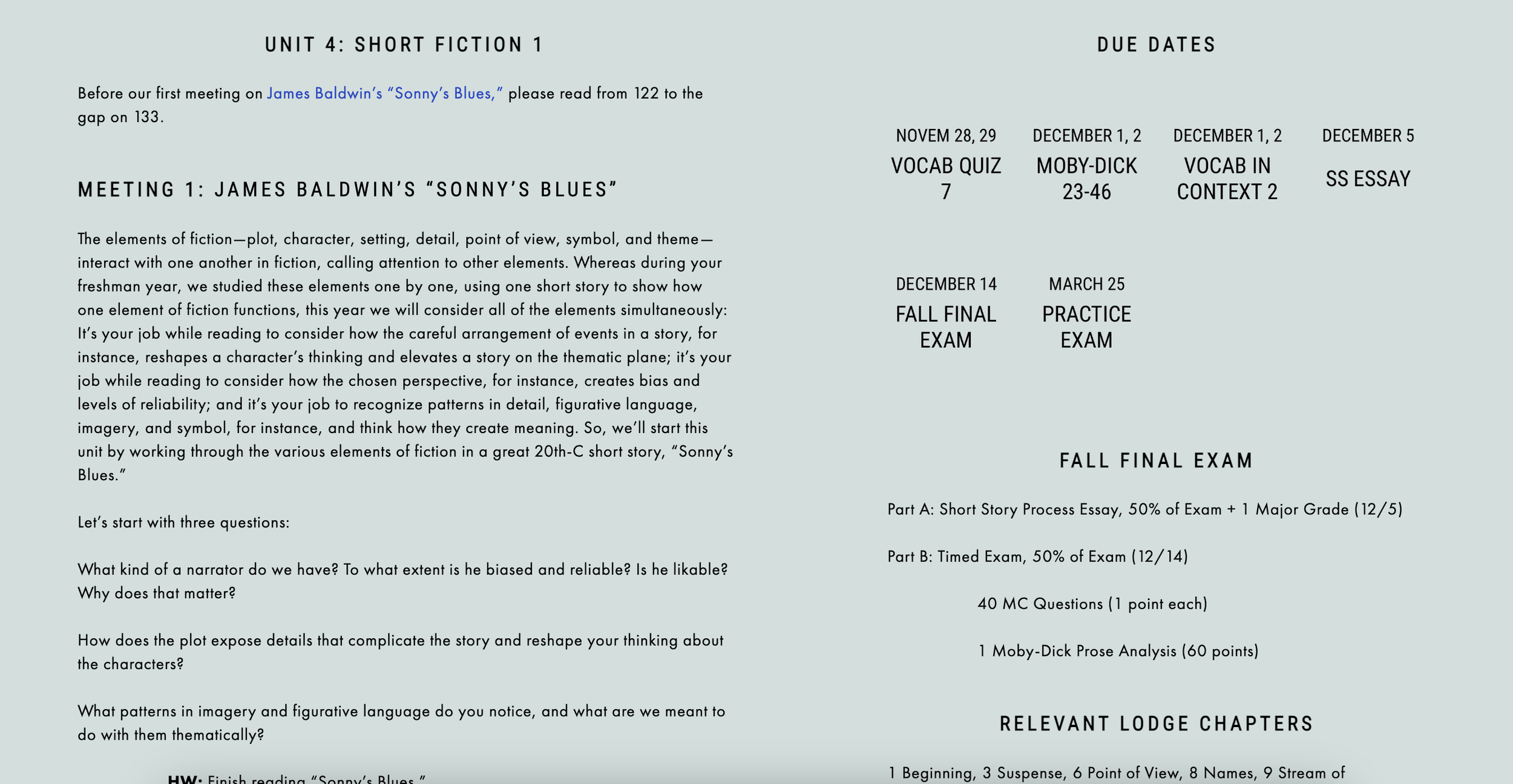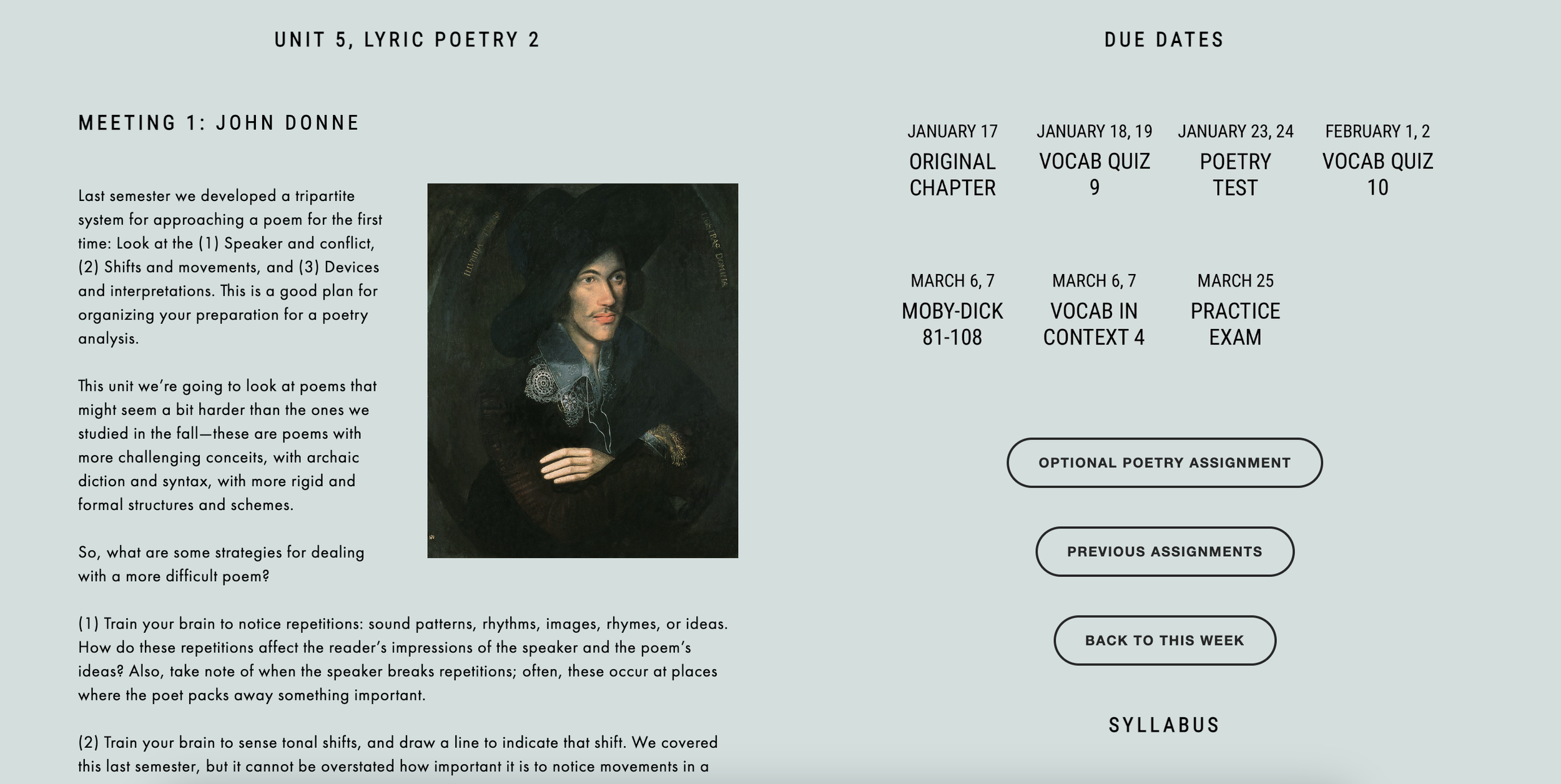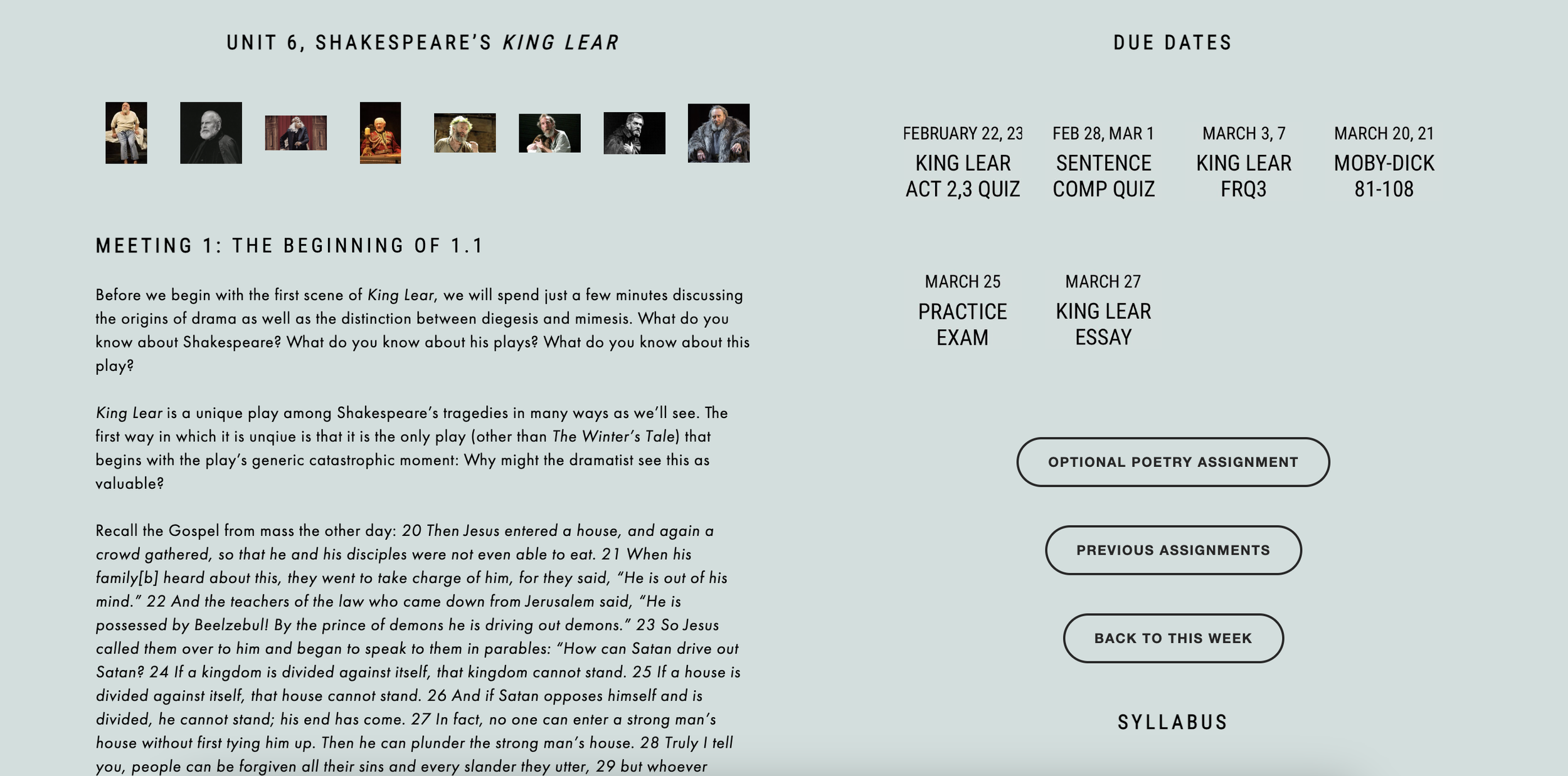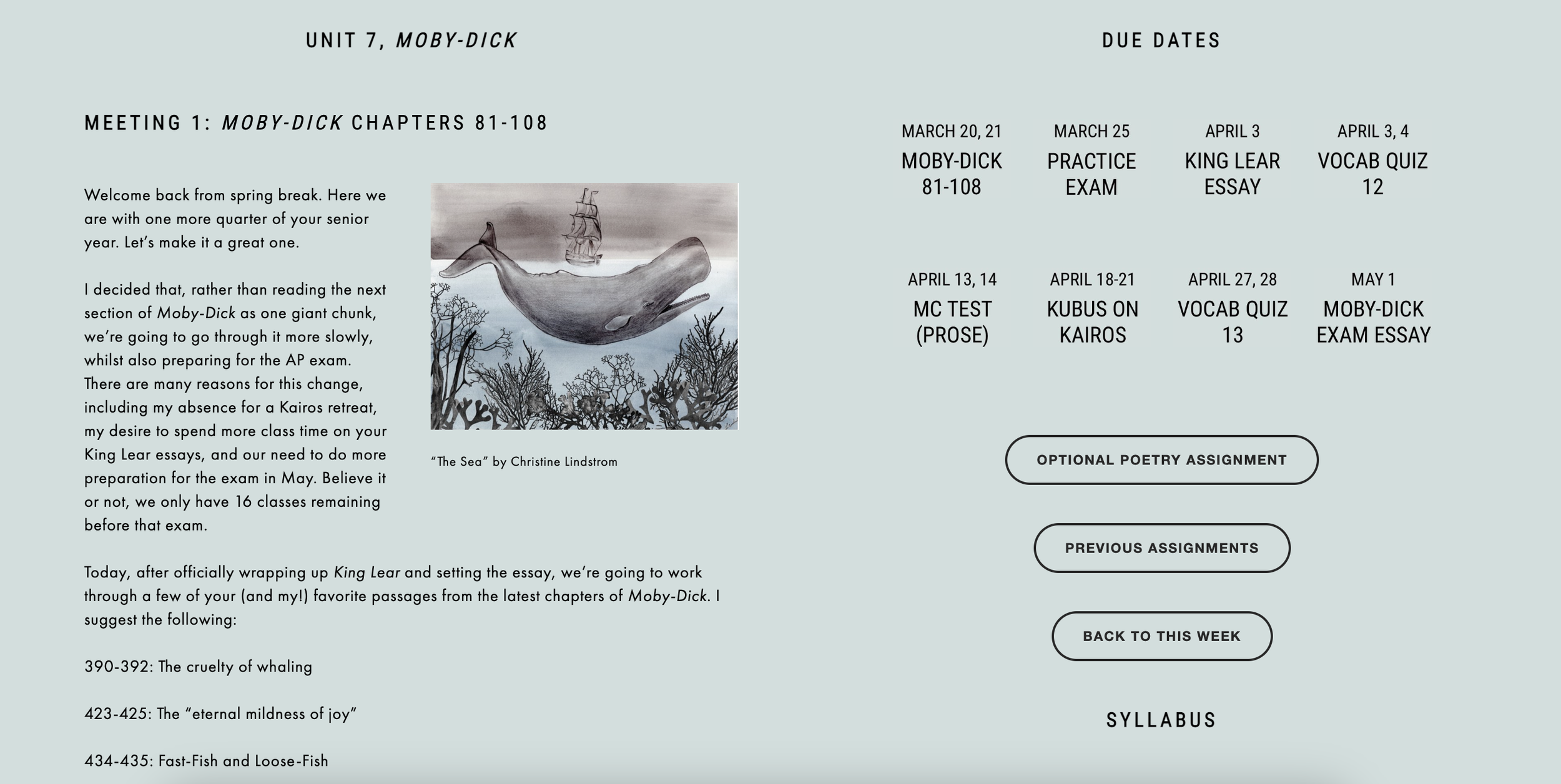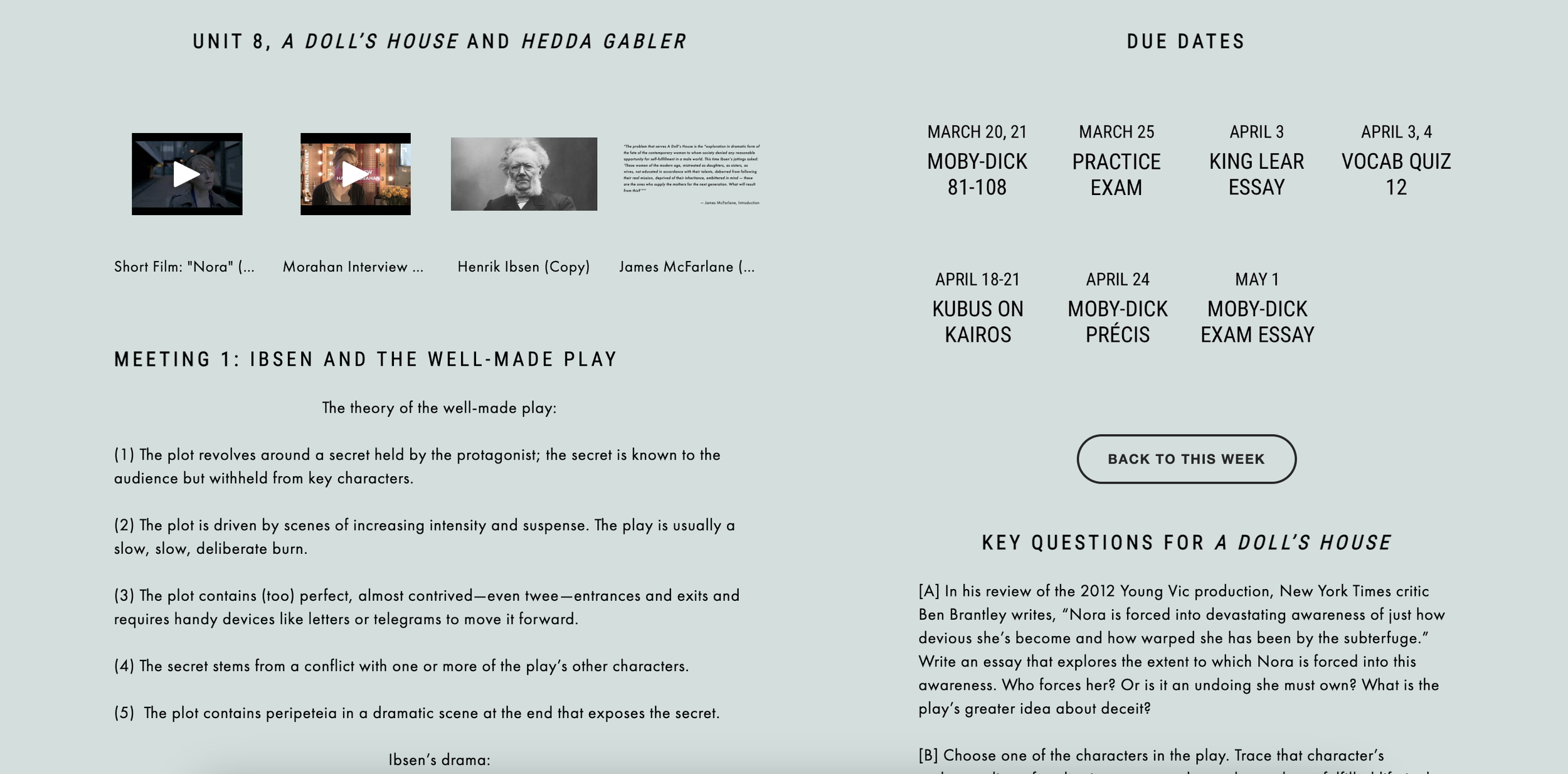unit 2: short fiction
MEETING 10: O’Connor, “a good man is hard to find”
Before O’Connor, Donne.
Consider what Flannery O’Connor has to say about theme:
“I prefer to talk about the meaning in a story rather than the theme of a story. People talk about the theme of a story as if the theme were like the string that a sack of chicken feed is tied with. They think that if you can pick out the theme, the way you pick the right thread in the chicken-feed sack, you can rip the story open and feed the chickens. But this is not the way meaning works in fiction. When you can state the theme of a story, when you can separate it from the story itself, then you can be sure the story is not a very good one. The meaning of a story has to be embodied in it, has to be made concrete in it. A story is a way to say something that can’t be said any other way, and it takes every word in the story to say what the meaning is. You tell a story because a statement would be inadequate. When anybody asks what a story is about, the only proper thing is to tell him to read the story. The meaning of fiction is not abstract meaning but experienced meaning, and the purpose of making statements about the meaning of a story is only to help you experience that meaning more fully.” — Flannery O’Connor
So, let’s do that, focusing mostly on the final scene of the story.
Homework:
(1) Read O’Connor, “The Life You Save May Be Your Own”.
(2) Read these selections from James Wood’s How Fiction Works. The selections come from a chapter called “Detail.” What is a literary detail? How does James Wood see it potentially working in fiction? Find one potent detail in each of the two O’Connor stories we’ve read so far.
MEETING 11: O’Connor, “the life you save may be your own”; mcq practice
Share with your CHAVRUSA:
What did you file away in “Things I Couldn’t Help but Notice”?
In what ways is “The Life You Save May Be Your Own” situationally similar to “A Good Man is Hard To Find”? Thematically?
Wood talks extensively about literary detail. Define it together. What examples do you have from either of the O’Connor stories?
Sample MCQ
Homework:
(1) Read O’Connor, “Everything That Rises Must Converge”. Messrs. Hoelscher, Al-Ramahi, LaRue, Perrilliat, and Orendain will team-teach the story with me.
(2) In the second half of our next class, you will tackle an MCQ set on a James Joyce passage. We will read and mark up the passage together. Then, you’ll have 20 minutes to answer the questions. There will be a square root curve.
MEETING 12: O’Connor, “everything that rises must converge”; mcq quiz
“Remain true to yourself, but move ever upward toward greater consciousness and greater love! At the summit you will find yourselves united with all those who, from every direction, have made the same ascent. For everything that rises must converge.” —Pierre Tielhard de Chardin
“If nothing but the bright side of characters should be shown, we should sit down in despondency, and think it utterly impossible to imitate them in anything. The sacred writers related the vicious as well as the virtuous actions of men, which had this moral effect, that it kept mankind from despair, into which otherwise they would naturally fall, were they not supported by the recollection that others offended like themselves, and by penitence and amendment of life had been restored to the favor of Heaven.” —Samuel Johnson
Messrs. Hoelscher, Al-Ramahi, LaRue, Perrilliat, and Orendain will team-teach the story with me in the first half of class.
MCQ Quiz—Prose
Homework:
No homework. Prose analysis debrief in our next class.
MEETING 13: prose analysis debrief
Today is a day to debrief the FRQ3s from last class. Let’s begin by looking back at the prompt and listing all of the different ways into the prompt. Then we’ll look at one very successful response.
—————
MEETING 7: baldwin, “sonny’s blues”
AP Classroom
The Anatomy of 50 Great Sentences: [A] and [I]
An opening thought about “Sonny’s Blues”? What are the biggest stylistic differences between Baldwin and Joyce? What does Baldwin do to shape our impressions of the narrator? What are those impressions at various points in the story?
During the second half of class, we’re going to look at a prose analysis passage and two responses from Ian McEwan’s novel Atonement. What should each be scored, according to the rubric?
Homework:
(1) Continue work on your prose analysis.
(2) Read David Lodge, “Time-Shift”. Identify a section of Lodge’s chapter that helps you better understand why Baldwin flashes back and forward in the way he does in “Sonny’s Blues”.
(3) Read David Lodge, “Repetition”. Then return to the first 5 paragraphs of “Sonny’s Blues”: Do as Lodge says by marking the syntactic and lexical repetitions Baldwin presents to you. To what thematic end do the repetitions and rhythms persist?
MEETING 8: baldwin, “sonny’s blues”
How do Lodge’s chapters “Time-Shift” and “Repetition” apply to “Sonny’s Blues”?
What does Baldwin do to shape our impressions of the narrator? What are those impressions at various points in the story?
During the second half of class, we’re continue to look at a prose analysis passage and two responses from Ian McEwan’s novel Atonement. What should each be scored, according to the rubric?
Homework:
(1) Continue work on your prose analysis.
MEETING 9: baldwin, “sonny’s blues”
Vocabulary Quiz
Sample Passage from “Sonny’s Blues”
Homework:
(1) Finish your prose analysis.
(2) Read O’Connor, “A Good Man is Hard to Find”.
——————
MEETING 1: joyce, “a painful case”
During class we’ll pass through the phases of our first short story of the year, which I’ve identified as follows: (1) The ordinary, ordered existence of Mr. James Duffy, (2) Mrs. Sinico wears away at the rough edges of Mr Duffy’s character, (3) Mr. Duffy exiles himself from life’s feast, (4) Mrs. Sinico’s suicide, (5) “A Painful Case”, (6) Mr. Duffy’s response, (7) Phantom Hand and Epiphany
Key points from today’s class:
(1) Setting can amplify our understanding of and even have an impact on a character’s interior life.
(2) As Mrs. Sinico reorients Mr. Duffy to a greater reality about himself, the 3rd-person narrator increases free-indirect discourse, mirroring Mr. Duffy’s increased emotional intelligence.
(3) The short story often relies on exactitude and careful placement of detail. “A Painful Case” relies heavily on sound and silence as an objective correlative to aid our understanding of Mr. Duffy.
Homework:
(1) Go back and trace references to sound and silence in “A Painful Case.” What are you being shown? How does the motif function?
(2) Read and annotate James Joyce’s short story “Araby” in Dubliners, pages 19-24.
(3) Read “Epiphany” in David Lodge’s The Art of Fiction, pages 146-8.
MEETING 2: joyce, “araby” and “eveline”
Hans Winter, “Chavrusa”
Today I’ll introduce you to your CHAVRUSA.
David Lodge says that an epiphany is any passage in which “external reality is charged with a kind of transcendental significance for the perceiver.” He goes on to say that some might seem like an anticlimax, a moment of defeat or frustration. That seems right in Dubliners. What’s the realization in the epiphanic anticlimax in both “A Painful Case” and “Araby”?
In the second half of class today, we’re going to read “Eveline” in five sections, in a style writer George Saunders recommends for approaching a new story for the first time. Divide your text as I indicate, and we’ll begin.
Why pair “Araby” and “Eveline” together? What do they have in common stylistically? What do they have in common thematically? Select a lens through which you can view both of Joyce’s stories. Work together to make a claim that differentiates the stories thematically.
Homework:
(1) Read and annotate James Joyce’s short story “The Sisters” in Dubliners, pages 1-9.
(2) Read “Point of View,” pages 25-9, and “Showing and Telling,” pages 121-124, in David Lodge’s The Art of Fiction.
MEETING 3: joyce, “The sisters”: point of view and dialogue
What was it like to work through the story in the way we did last class? Recall the questions: (1) What does the author set in motion? (2) How does the story expand? (3) What do you anticipate? (4) How does the story turn, and where? (5) Is this the promised end?
I’ll ask one student to walk us through his takeaways from David Lodge’s chapter “Point of View.” Let’s use the chapter to think about Joyce’s handling of point of view in the stories we’ve read so far. What is an unreliable narrator?
How does the child narrator’s point of view keep us from understanding the potentially sinister doings of Father Flynn? Why choose that POV?
I’ll use the remainder of our time to introduce prose analysis. We’ll use a passage from “Eveline”.
Key points from today’s class:
(1) Perspective refers to how narrators, characters, or speakers see their circumstances, while point of view refers to the position from which a narrator or speaker relates the events of a narrative.
(2) Choosing a point of view is the single most important decision an author makes before sitting down to write the story: What would “The Sisters” be if written from the point of view of Cotter? What would “A Painful Case” become if we didn’t have a limited 3rd-person narrator and occasionally heard Mrs. Sinico’s perspective? Well, they’d both be very different stories, indeed.
(3) Prose Analysis (FRQ2) requires you to find complexity in a passage and arrange your line of reasoning around that complexity.
Homework:
(1) Read and annotate the first half of James Joyce’s short story “The Dead” in Dubliners, pages 151-75, stopping just after “He began:”.
(2) Read “The Sense of Place” in David Lodge’s The Art of Fiction, pages 56-60. THINK: You’re now on your 5th Dubliners story—How does Joyce use ways of speaking and the description of the city to evoke a sense of place? Read “Weather” in David Lodge’s The Art of Fiction, pages 84-88.
(3) Study for your first vocabulary and sentence composition quiz.
MEETING 4: joyce, “The sisters” and “The dead”
Today begins with the first vocabulary and sentence composition assignment.
What questions do you still have about prose analysis? Let’s review the thesis statements for prose analysis.
We will then review the latest Lodge chapters and apply his observations about setting, weather, point of view, and dialogue to the 5 stories we’ve read in Dubliners.
Homework:
(1) Read and annotate the second half of James Joyce’s short story “The Dead” in Dubliners, pages 175-94.
MEETING 5: joyce, “The dead”
Your notes pages on Lodge and Dubliners.
Homework:
(1) In his dinner speech, Gabriel says,
“Our path through life is strewn with many such sad memories: and were we to brood upon them always, we could not find the heart to go on bravely with our work among the living.”
And yet at the end of the story, the narrator takes Gabriel’s perspective and says in free-indirect style,
“One by one, they were all becoming shades. Better pass boldly into that other world, in the full glory of some passion, than fade and wither dismally with age.”
Gabriel’s dinner speech anticipates the final moments in the story. In which instance is Gabriel speaking the “truth”?
(2) Review the stories we read together in Dubliners and the corresponding Lodge chapters. You’ll have a quiz in the second half of our next class. The quiz will assess both your knowledge of the stories and how elements of fiction work in passages from the stories.
MEETING 6: joyce, “The dead”
AP Classroom
Dubliners quiz
Homework:
(1) Begin work on your prose analysis.
(2) Read James Baldwin, “Sonny’s Blues”, pages 103-41.














